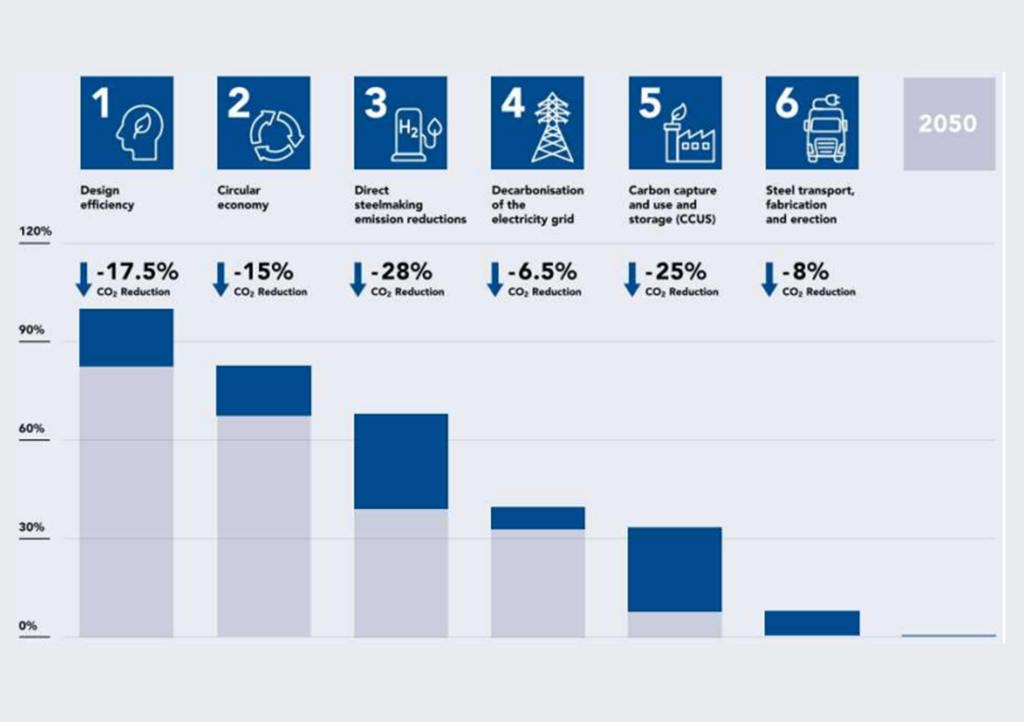Industry leaders have published new guidelines on how structural steel contractors can work to decarbonize their operations.
The British Steelwork Contractors Association (BCSA) has yesterday(Monday, November 22) launched ‘UK Structural Steelwork: 2050 Decarbonisation Roadmap’.
The 22-page Roadmap sets out how the sector can work collaboratively and realistically to achieve targets of net zero carbon emissions by 2050.
The intention is to deliver a “genuinely circular and sustainable structural steel sector”, BCSA bosses have said. They add that the ambition is for truly sustainable construction, with all steel structures “adapted or extended to prolong their lifetimes [and] deconstructed for reuse or recycling at end of life”.
The Roadmap is aimed at designers, steelwork contractors, steel producers, stockholders and demolition contractors alike. Its publication follows Cop26, where world leaders set out global plans on how to meet net zero carbon targets.
The six decarbonisation levers
The Roadmap recognizes that while great strides have been made in reducing the carbon intensity of steelmaking, more can, and must, be done. It has been developed based on six strategies – or levers – each utilising technologies already proven or being piloted. Each has been ranked on its feasibility and application, using Technology Readiness Levels (TRLs).
The levers cover:
- Design efficiency
This strategy sets out the benefits of delivering smarter, more efficient, structural designs – in short, using structural steel to achieve more, or as much, with less. Design efficiency can be delivered by reducing over-specification of steel or design loads. It can also be achieved through extending a building’s lifetime by adjusting its structure and design to allow for adaptability of layout and flexibility of use.
By refining design efficiency, a 17.5% reduction in CO2 can be achieved. This is seen as an advanced and readily achievable lever since designers and contractors already have the skills and understanding to implement more efficient design.
- Circular economy
Steel already plays an important part in the UK’s circular economy, with 99% of it recovered through a well-established scrap network – 86% for recycling, 13% for reuse. Looking at steel’s whole-life carbon footprint is essential to this – it is closely linked to design efficiency through clever design to extend a building’s life or to ensure it can be efficiently dismantled for reuse.
Implementing circular economy techniques can deliver a 15% reduction in CO2. This is also a highly achievable lever, workable through whole-life carbon assessments. However, the Roadmap notes that for the volume of structural steel available for reuse to increase, logistical challenges must be addressed and navigated.
- Direct steelmaking emission reductions
Since the blast furnace element of basic oxygen furnace (BOF) steelmaking currently accounts for around 70% of its emissions, this is a real priority for decarbonisation. The Roadmap outlines how these emissions can be reduced in a number of ways, including: waste heat recovery, coke dry quenching or top pressure recovery turbines to generate electricity as a by-product from the process; or, using biomass or biowaste to generate energy for steelmaking.
Reducing direct steelmaking emissions can contribute a 28% reduction in CO2, however the feasibility of this is not fixed due to the variety, size and scale of the changes required.
- Decarbonisation of the electricity grid
Decarbonising the electricity grid which powers so much of the industrial process will support ‘greener’ steelmaking. This will generate affordable renewable energy, as the UK’s electricity grid is set to be decarbonized by 2050, with a significant amount of this achieved by 2030.
Decarbonisation of the electricity grid can create a 6.5% reduction in CO2.
- Carbon capture and use and storage (CCUS)
CCUS uses technologies to capture CO2 from power generation or industrial facilities to either reuse this on-site or to be compressed and stored naturally for later reuse. Carbon capture and use (CCU) converts the carbon into useful, commercially viable products, to be used instead of fossil fuel-led products. Carbon capture and storage (CCS) permanently stores the carbon.
Better carbon capturing, using and storage can deliver a 25% reduction in CO2. This is a highly viable solution since CCUS technologies can be retrofitted in existing steelmaking plants while newer forms of the technologies are also under development.
- Steel transport, fabrication and erection
This element of decarbonisation is already well underway by BCSA members, measuring and managing their carbon footprint using industry-approved tools and solutions. The Roadmap outlines how these can be further improved through the use of renewable energy across all operations – extending from just renewable electricity for fabrication to implementing electric vehicle and plant fleets, for example.
By improving steel transport, fabrication and erection, an 8% reduction in CO2 can be achieved.
BCSA’s Roadmap intends to offer the industry “flexibility to respond and react” through a variety of solutions and closely linked levers.
Its authors say that while the transition to carbon net zero will be “a complex journey”, “given the right policies, incentives and financial support, the technologies outlined … can deliver decarbonized steel structures by 2050”.
To read the Roadmap in full, click here.
The Roadmap is the latest in a range of guidelines produced by the BCSA to support sustainable construction. Its Sustainability Charter ensures steelwork contractors are accountable for achieving net zero carbon targets and is regularly revised to advise on the latest processes and practices to deliver environmentally-friendly and socially-minded solutions.

